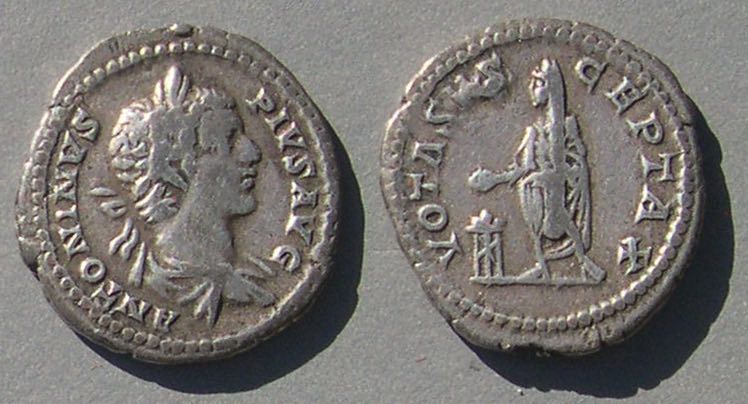 VOTA coins of the Roman Empire
VOTA coins of the Roman Empire  VOTA coins of the Roman Empire
VOTA coins of the Roman Empire
Roman emperors took vows (VOTA) promising to do something for the gods if the gods did something the emperor wanted. The emperor wanted a long reign, of course, and many coin types mention "VOT X"-- vows for ten years of reign. Under the empire, vows were noted on coins first with very rare types under Augustus and then, after a long gap, with Hadrian and many subsequent emperors. When they are vows made or renewed they are "taken" -- SVSCEPTA (see the coin to the right: VOTA SVSCEPTA X). If the emperor actually lasts that long, the promise must be "fulfilled"-- SOLVTA (see the second coin: VOTA SOLVTA DEC, "DEC" for "10" years). Both taking and fulfilling vows appear on Roman coins.
Taking Vows. At the upper right is a silver denarius (19 mm) of the Roman emperor we call by his nickname
Caracalla (AD 196-198-217, named "ANTONINVS PIVS" on his coins) with reverse
VOTA SVSCEPTA X (vows for ten years taken)
Emperor in priestly garb (veiled and togate) sacrificing, holding out patera (a shallow bowl) over a tripod altar.
Sear II 6909.
What's new?: 2024, July 16: Each photo on this page (but not the other pages of this VOTA site) is linked to a large image; just click on the photo.
2024, April 3: Hadrian VOT PVB.
2022, June 13: Cararcalla Suscepta, Caracalla Soluta.
Table of Contents:
This page: An overview, largely in chronological order, with links to the other pages. More about the ceremony quoted from Livy.
Other Pages: VOTA coins of the second century
Roman women and VOTA PVBLICA
Dating VOTA coins
PRIMI DECENNALES and VOTIS DECENNALIBVS
VOTA coins of the third century
VOTA coins of the first Tetrarchy (late third century)
Fractional folles of the first tetrarchy (most of which are VOTA coins)
VOTA coins of Maxentius (early fourth century)
Vows for year 5 (VOT V) on Roman coins of Constantine II, Crispus, and Licinius II, issued c. 320-321. Also, related vota coins from Thessalonica
VOT X, VOT XX, and VOT XXX under Constantine AD 320 and later
Vows for year XV of Constantine, with Licinius, c. 318-319
Vota coins of Magnentius and Decentius, 350-353
Vota coins of Julian II and Jovian, 361-364
VOTA on late Roman coins, Valentinian through Theodosius II and Valentinian III (AD 364 - 455 in RIC IX and X)
Byzantine VOTA coins
This site was inspired by the collection of the late Jeff Clark of Cheyenne, Wyoming, whose interest in vota coins was unsurpassed. The next coin was his.
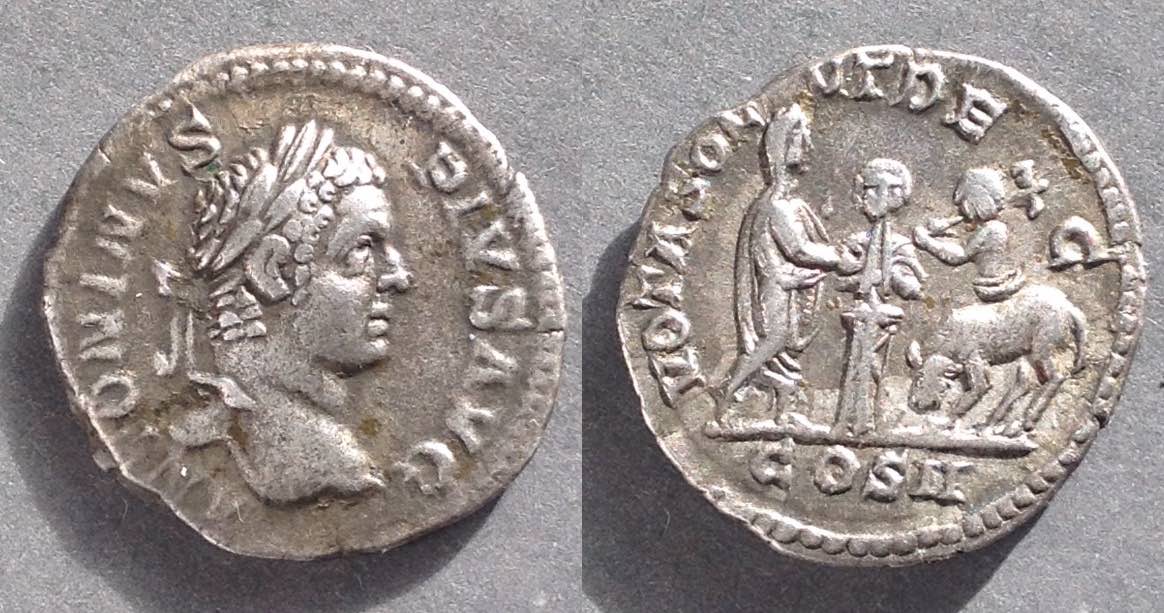 Fulfilling Vows. This rare "SOLVTA" type of Caracalla shows a part of the occasion when vows were fulfilled. The legend is
Fulfilling Vows. This rare "SOLVTA" type of Caracalla shows a part of the occasion when vows were fulfilled. The legend is
VOTA SOLVT DEC (vows for ten years fulfilled)
with COS II in exergue.
A silver denarius of Caracalla, struck c. 207 AD.
Caracalla standing right holding patera over tripod altar, flute (with two pipes) player facing behind the tripod altar, a sacrificial bull about to be slain by a victimarius with raised ax. A scene with action!
Sear II 6907 variety (Sear's has COS III).
The Festival. Votive festivals were part of the Roman religion. Ceremonies included performing libations and the burning of incense (the first coin), the sacrificing of animals (the second coin, just above), and games. Almost any occasion could provoke an arrangement with a god with a particular reward promised for fulfillment. For example, a general about to go off to war might promise a particular percentage of the booty to the god Jupiter Optimus Maximus (at the temple in Rome) in addition to the usual sacrifice. For a sea traveler, a vow might promise something to Neptune or Fortuna for a safe arrival. At the beginning of every year there were annual public vows (on January 3, starting in A.D. 38) for the welfare of the emperor and the empire taken by all magistrates and all priestly colleges and at the same time last year's vows were paid [Rupke]. If the desired result did not come to pass, the vow did not have to be paid. It was very much an "if..., then..." contract. For emperors, there was generally an event at the beginning of the reign (for vows suscepta for ten years) and one after the tenth regnal year (for vows soluta) which simultaneously served for renewing vows (suscepta for twenty years). The ten-year anniversary was the decennalia.
 Vows Renewed. At the right is a silver denarius of Septimius Severus (AD 193-211) with vows taken (suscepta) for 20 (XX) years. Because vows were primarily for ten year periods, on this coin with vows "SVSCEPTA XX" vows for "X" are being paid (soluta) and renewed for "XX" in a ceremony for year 10. Septimius Severus began his reign in 193, so this coin type is appropriate for anticipating or commemorating the event of 203.
Vows Renewed. At the right is a silver denarius of Septimius Severus (AD 193-211) with vows taken (suscepta) for 20 (XX) years. Because vows were primarily for ten year periods, on this coin with vows "SVSCEPTA XX" vows for "X" are being paid (soluta) and renewed for "XX" in a ceremony for year 10. Septimius Severus began his reign in 193, so this coin type is appropriate for anticipating or commemorating the event of 203.
Septimius Severus (AD 193-211). Denarius. 19 mm.
VOTA SVSCEPTA XX, the emperor veiled and draped as a priest sacrificing, pouring from a patera over a flaming altar, with legend
RIC 308 "202-210". Sear 6393. BMC 375 "201-210".
Vows in the Second Century. Second-century vota types include the emperor sacrificing (as above), vows in a wreath (next) and the legend PRIMI DECENNALES ("the first decennalian games") in a wreath.
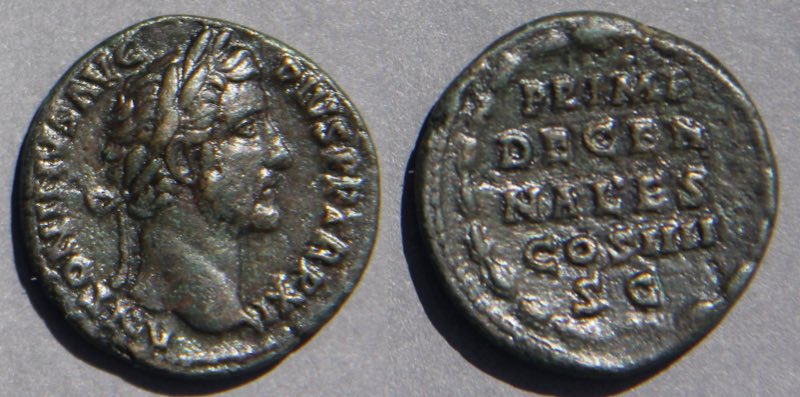 The legend PRIMI DECENNALES in a wreath. This vota type does not explicitly say "VOT," rather it refers to the event, the celebratory decennalian games.
The legend PRIMI DECENNALES in a wreath. This vota type does not explicitly say "VOT," rather it refers to the event, the celebratory decennalian games.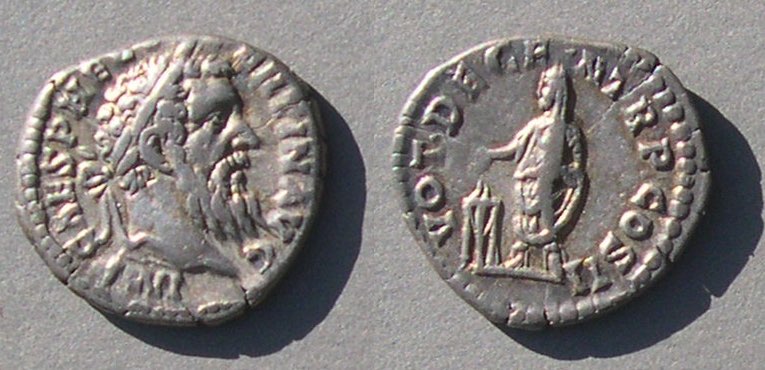
Pertinax, Jan. 1 - March 28, 193 (86 days)
Denarius. 18-17 mm.
IMP CAES P HELV PERTIN AVG
VOT DECEN TRP COS II
Pertinax standing left, holding patera over tripod altar
Sear II 6048. RIC 13a "R2". BMC 24
Although he reigned only 86 days, he issued this type with vows for ten years. Clearly they are vows taken (suscepta). The Pius piece above refers to vows for ten years paid (soluta) as can be seen by the TRP XI date, but this coin proves that vows for ten years can be recorded on coins from the beginning of the reign.
(Go to a page on vota coins of the second century.)
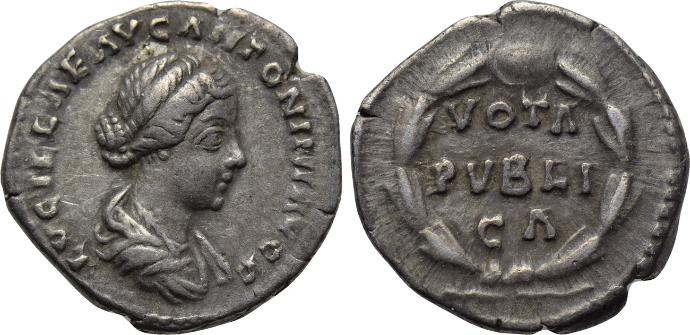 VOTA PVBLICA. Some vows types are without numbers. Vows on coins struck for women do not have year numbers.
VOTA PVBLICA. Some vows types are without numbers. Vows on coins struck for women do not have year numbers.
Lucilla (wife of Lucius Verus, 161-169, and daughter of Marcus Aurelius and Faustina II)
Denarius. 18 mm.
LVCILLAE AVG ANTONINI AVG F
VOTA/PVBLI/CA in wreath.
Sear II 5494. RIC 791 (under Marcus. "Scarce"). BMC 329 "169".
BMC proposes that this type commemorates the vows at her marriage in 169 to a distinguished knight, after Lucius died. [BMC cxxxiv.]
Vows on Coins in the Third Century. Many vota types in the third century reprise those of the second century. There are new types with Victory inscribing a shield and issues with the year more-or-less spelled out.
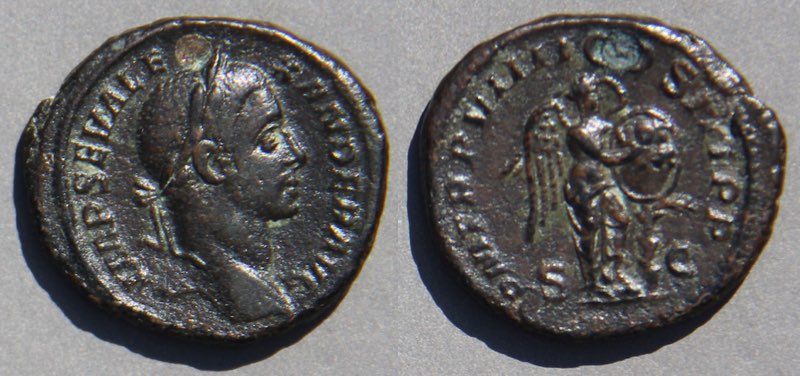 Victory inscribing a shield. Vows are sometimes recorded by a single Victory inscribing a shield.
Victory inscribing a shield. Vows are sometimes recorded by a single Victory inscribing a shield.
An as of Severus Alexander (222-235). 26-24 mm. (Holed and plugged at 12:00.)
IMP SEV ALEXANDER AVG
PM TRP VIIII COS III PP
Victory inscribing VOT X on a shield.
TRP VIIII shows this coin was struck in regnal year 9, not year 10, but the situation is confused by his having been appointed Caesar in 221, the year before he became Augustus. Maybe the vows mentioned were vows taken when he became Caesar.
(If you are interested in the principles of dating vota coins, first continue on this page to have enough examples, and then
go to a page on dating vota coins. There are other links to it further down.)
"DECENNALIBVS" spelled out. This denarius of Maximinus Thrax (235-238), the Giant, was one of his first issues within a few months of becoming emperor. We can date it by its "early" portrait which resembles that of the previous emperor, Severus Alexander. That portrait was soon superceded when Rome learned more about what he actually looked like. (For the dating of this early style, see Maximinus Thrax, the Giant.)
IMP MAXIMINVS PIVS AVG
VOTIS/DECENNA/LIBVS (vows for ten years) in a wreath.
20-19 mm. RIC 17 (Rome mint). Sear 8319. BMC 39. Reka Devnia: Among 1721 coins of Maximian only 1 was of this type.
These vows for ten years must be suscepta because he did not last enough for them to be soluta.
 A type of Gallienus combines the "Victory inscribing a shield" design with the "DECENNALIA" spelled-out legend.
A type of Gallienus combines the "Victory inscribing a shield" design with the "DECENNALIA" spelled-out legend.
Gallienus. 253-268. 22-21 mm.
Struck 262-263 at Mediolanum
GALLIENVS AVG
VOTA DECENNALIA around
Victory inscribing shield on palm tree, P in field left
RIC V.I 540
Very rare.
Cunetio 1352-4 had 11 examples with this legend, none with the "P", among 14,429 coins of Gallienus and Salonina.
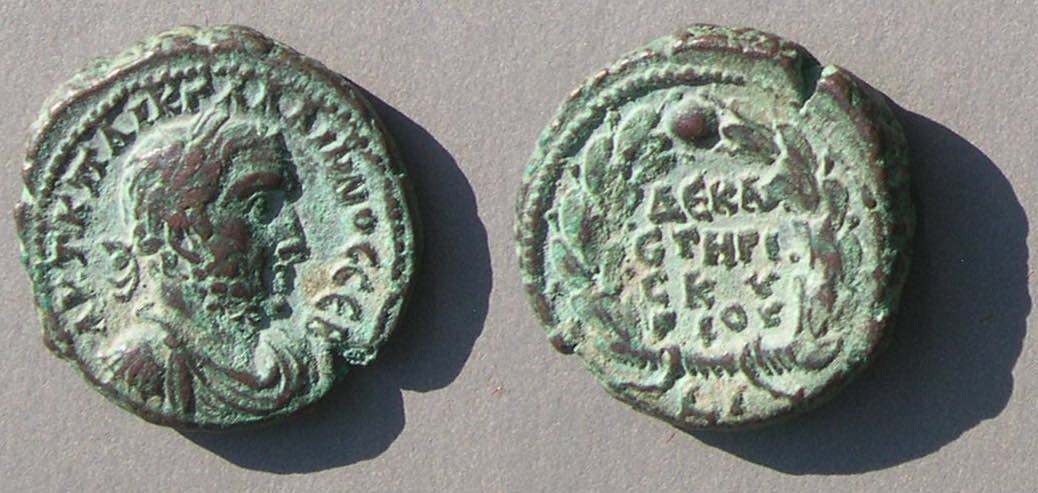 Roman Alexandria, Egypt. Almost all vota types are Roman imperial types. Here is one that is unusual for being a Roman provincial type. It is from Roman Alexandria.
Roman Alexandria, Egypt. Almost all vota types are Roman imperial types. Here is one that is unusual for being a Roman provincial type. It is from Roman Alexandria.
Gallienus, 253-268, at Alexandria Egypt.
Tetradrachm. 24 mm. 11.28 grams.
AVT KΠ ΛIK ΓAIΛΛHNOC CEB
ΔEKA/ETHPI/CKY/PIOY "Dekaeteris Kyrious" "Decennalia of the Lord"
LI below, for "year 10".
Struck year 10, 262/3.
Emmett 3840 (This is the only year of this type, for obvious reasons)
 Postumus, Gallo-Roman emperor, summer 260- spring 269.
Postumus, Gallo-Roman emperor, summer 260- spring 269. Vows with Two Numbers. Vota coins are uncommon in the second half of the third century. This rare type of Probus (276-282) is perhaps the first to express vows for two anniversaries.
Vows with Two Numbers. Vota coins are uncommon in the second half of the third century. This rare type of Probus (276-282) is perhaps the first to express vows for two anniversaries.Later, in the fourth century, it is common for VOTA types mention two years (here, 10 and 20). In this case (and other cases) the emperor did not last long enough for the lower number to be for vows soluta. These might be vows taken (suscepta) at the beginning of the reign for both ten and twenty years at the same time. It is known that there were 5-year anniversaries and later (under Constantine) they were recorded on coins. RIC attributes quite a few "VOT X" coins to the time of the 5-year celebration, the quinquenallia. That opens the possibility this coin was issued at the quinquenallia.
(Continue below, or go to a page on vota coins of the third century, or go to a page on dating vota coins.)
Vows under the Tetrarchy. Chronologically, the first vota coins under the tetrarchy are aureliani (aka antoniniani) struck shortly before the coin reform of 294 for the decennalia (10 years) of Diocletian. At the same time, vows were taken (renewed) for twenty years.
Diocletian, 284-305
24-22 mm. 3.80 grams.
PRIMIS X MVLTIS XX (First 10, multiplied to 20)
Victory inscribing shield on palm VO/TX
XXIZ in exergue.
IMP DIOCLETIANVS AVG
RIC V.II Diocletian 177H, page 238 "Rome, 293-5"
Vota soluta for ten years and suscepta for twenty.
Diocletian took a co-augustus early in his reign and created the "First Tetrarchy" in 293 by elevating Galerius to be his Caesar and Constantius to be Caesar for Maximian. Some of the final aureliani (= antoniniani) of Diocletian and Maximin before the coin-reform of c. 294 mention ten- and twenty-year vows, but the types of Galerius and Constantius do not.
(Go to additional aureliani of the tetrarchy, as well as the other vota types of the first tetrarchy.)
Post-reform Radiates. After the coin reform Carthage issued post-reform radiate vota coins for the Augusti (Diocletian and Maximian) and the Caesars (Constantius and Galerius) for the occasion of Diocletian's vicennalia (twenty years) in 303.
Diocletian, 284-305.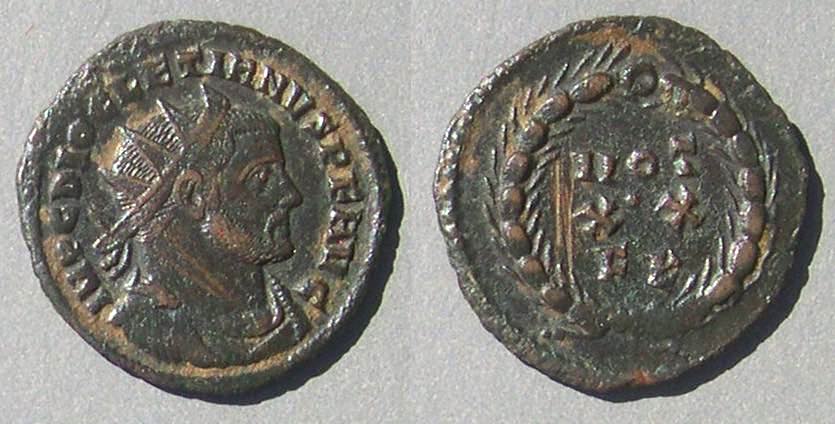
20 mm. "Post reform radiate".
VOT/XX/F K (vows for 20, Felix Karthage)
RIC VI Carthage 37a page 427, struck "c. 303".
If RIC's date is right, the vows are soluta. Diocletian's reign lasted longer than 20 years and this vota festival would have been at the beginning of the twentieth regnal year, 303 as given by RIC. Another possibility is that the vows are suscepta, issued as soon as the Carthage mint opened after the tenth anniversary.
Rome issued similar types.
 Vows on Tetrarchal AE Fractions. For some unknown reason rare fractional folles were struck at Trier (and some very rare ones at Lyon, Ticinum, and Siscia) beginning with Diocletian and continuing through Constantine. They are all laureate, not radiate, and come in three denominations. Zschucke (Die Bronze-Teilstuck-Pragungen der romischen Munzstatte Trier) categorizes most of the Trier types as 1/8 or 1/4 follis pieces. Later, under Constantine, when the follis itself was much reduced in size, he categorizes the largest of the small denominations as a 1/2 follis piece.
Vows on Tetrarchal AE Fractions. For some unknown reason rare fractional folles were struck at Trier (and some very rare ones at Lyon, Ticinum, and Siscia) beginning with Diocletian and continuing through Constantine. They are all laureate, not radiate, and come in three denominations. Zschucke (Die Bronze-Teilstuck-Pragungen der romischen Munzstatte Trier) categorizes most of the Trier types as 1/8 or 1/4 follis pieces. Later, under Constantine, when the follis itself was much reduced in size, he categorizes the largest of the small denominations as a 1/2 follis piece.
Small. 14 mm. ("1/8" follis).
Diocletian. 284-305.
DIOCLETI-ANVS AVGG
VOT/XX/AVGG in wreath
RIC VI Trier 610a, page 201, "c. Sept. 303". Zschucke 4.2. "for the vicennalia of Diocletian in Sept. 303."
There are over 200 varieties of fractional folles, all rare, that record vota. One of the most intersesting types is of Maximian with vows for thirty years.
Maximian, 286-305 and 306-308. Second reign. Struck for July 25, 307.
Small. 14-13 mm
VOT/XXX /AVG in wreath
RIC VI Trier 751
Zschucke 6.7a, this coin
Diocletian abdicated after twenty years and forced Maximian to abdicate at the same time, so there would not have been an occasion for thirty-years vows had Maximian not rejected the decision and attempted to reassume power. After a falling-out with his son Maxentius he joined Constantine in Gaul, lending the prestigue of a senior emperor to Constantine who had an army, while Maximian did not. These XXX fractions were struck at Constantine's main mint, Trier.
(See here for more about these fractions.)
(See here for vota coins of Maxentius, 306-312, not discussed on this page.)
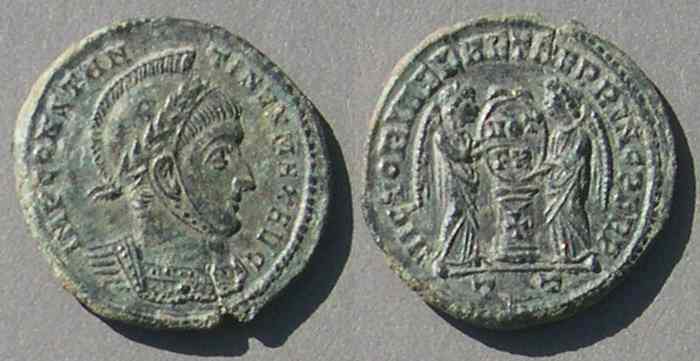 The "Two Victories" Type. At about this time Constantine introduced the "two Victories" type.
The "Two Victories" Type. At about this time Constantine introduced the "two Victories" type. 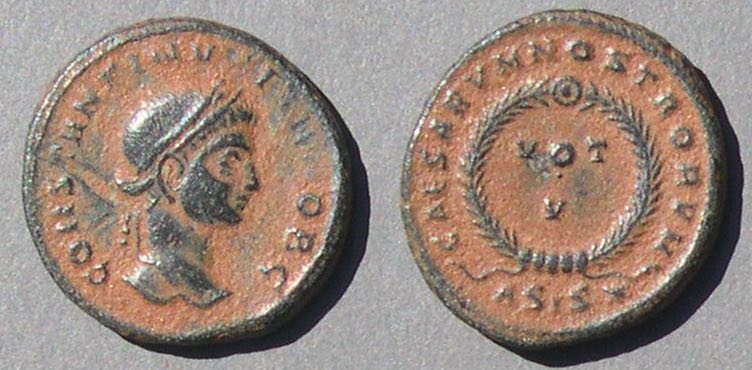 Vows for Five Years. Until the time of Constantine vows recorded on coins had been for ten or twenty years. The first large issue recording vows for five years was for the three Caesars who were elevated in 317. "VOT V" coins are common for his sons, Crispus and Constantine II, and also for Licinus II. The fifth anniversary of accession was the quinquennalia. We know vows for multiples of five years were taken under Tiberius and later, but they do not appear on coins until a small issue under Maxentius c. 310 (with "QQ"), another under Licinius (of uncertain date), and then these c. 320-321.
Vows for Five Years. Until the time of Constantine vows recorded on coins had been for ten or twenty years. The first large issue recording vows for five years was for the three Caesars who were elevated in 317. "VOT V" coins are common for his sons, Crispus and Constantine II, and also for Licinus II. The fifth anniversary of accession was the quinquennalia. We know vows for multiples of five years were taken under Tiberius and later, but they do not appear on coins until a small issue under Maxentius c. 310 (with "QQ"), another under Licinius (of uncertain date), and then these c. 320-321.
Constantine II (317-337-340). AE3. 18 mm.
CONSTANTINVS IVN NOB C (Constantine Junior, Noble Caesar)
The reverse legend is plural:
VOT/V in wreath. CAESARVM NOSTRORVM ("of our Caesars") around.
ASIS* in exergue for Siscia
RIC VII Siscia 163 struck "320-321".
(Go to a page with more about VOT V coins including additional type-variants and examples in the names of other rulers.)
Vows at Thessalonica. Constantine and Licinius fought two wars, but were at peace at the time of their 10-year anniversary, c. 318. At that time Thessalonica issued types with vows for 20 years for Constantine and Licinius and similar types with vows for 5 years for their sons Crispus, Constantine II, and Licinius II.
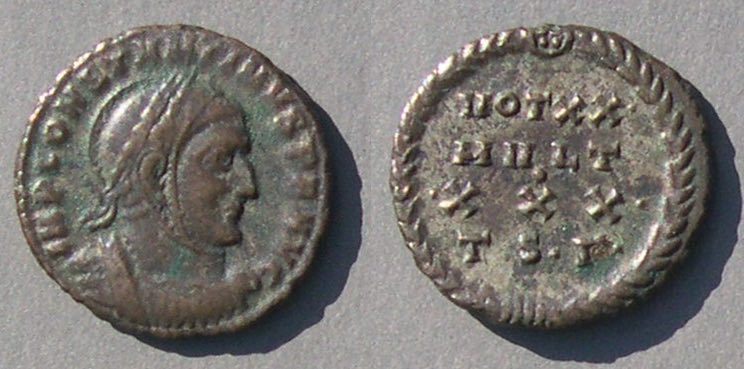 Constantine, 307-337
Constantine, 307-337
Issued 318-319
VOT XX
MVLT
•XXX•
TS•Γ•
RIC Thessalonica 28Γ.
(See here for more vota examples from Thessalonica.)
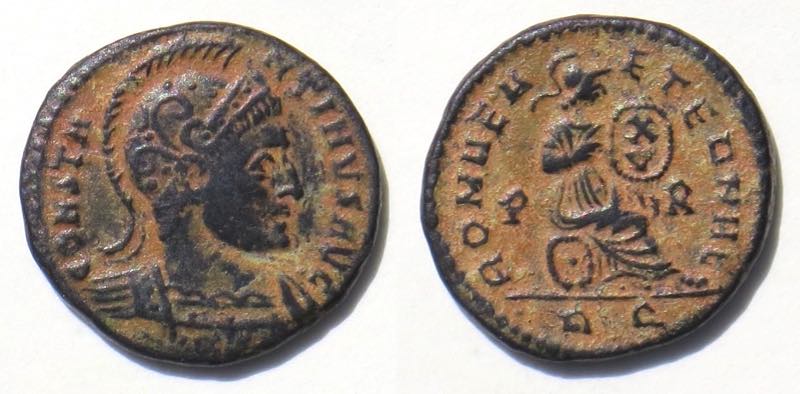 Vows for Fifteen Years. Vows for fifteen years are less common. The issue of Constantine recording vows for 15 years of Constantine is dated to the same time as the issue recording 5 years for the Caesars.
Vows for Fifteen Years. Vows for fifteen years are less common. The issue of Constantine recording vows for 15 years of Constantine is dated to the same time as the issue recording 5 years for the Caesars.  Vows for X and XX years. There are numerous "VOT X" and "VOT XX" types struck from 320-325.
Vows for X and XX years. There are numerous "VOT X" and "VOT XX" types struck from 320-325.
Constantine, 306-307-337.
VO
TIS
XX on altar with globe and three stars above
BEATA TRANQVILLITAS around
•PTR<crescent>
RIC VII Trier 390, "323"
This example has a bust of Constantine right in consular robes, holding an eagle-tipped scepter. The basic type is common and comes in very many varieties.
(Go to a page with more about X and XX coins, including more types from this time period and examples of this type in the names of his co-rulers.)
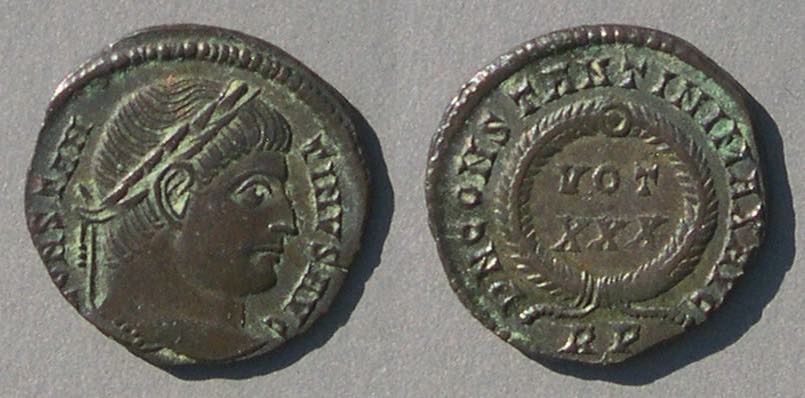 Constantine, 306-307,337
Constantine, 306-307,337
VOT
XXX in wreath
CONSTANTINI MAX AVG around
R P in exergue
RIC Rome 318 "S, 329"
Vows for thirty years could have been struck anytime after the ceremony for twenty years which was in 326.
(See here for an eyes-to-heaven example.)
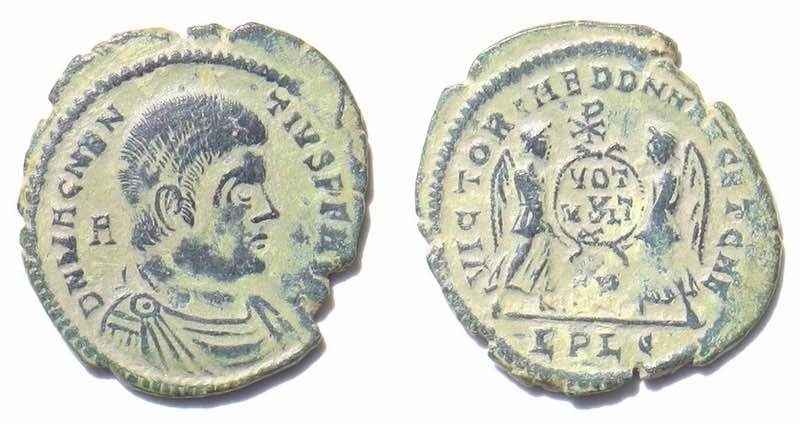 VOT V MVLT X. The issue of types referring to vows for both five and ten years was common on coins of the Gallic usurpers Magnentius and Decentius and later emperors. They are vows suscepta taken for both 5 and 10 years at the beginning of the reign.
VOT V MVLT X. The issue of types referring to vows for both five and ten years was common on coins of the Gallic usurpers Magnentius and Decentius and later emperors. They are vows suscepta taken for both 5 and 10 years at the beginning of the reign.
Magnentius, 350-353. 24-23 mm.
Two victories holding a shield inscribed VOT/V/MVLT/X
VICTORIAE DD NN AVG ET CAE around
Christian chi-rho above shield,
LPLG for Lugdunum in exergue
RIC VIII Lugdunum 140.
(Go to a page with additional vota coins of Magnentius and Decentius.)
RIC dates this type to the entire period of his reign. Above we saw a coin of Probus with two different numbers, the smaller of which was too large (10) to be for vows soluta. We see that again with this coin of Magnentius. He did not reign long enough for the 5th year vows to be soluta, although one might argue the type merely anticipates the occasion by a year. But that cannot be because the type is associated with various sequential mint and control marks that convince us it was issued throughout the reign. Mathisen thought all such combinations under Constantine were vows for five years soluta and for ten years suscepta, but these had to be both suscepta, especially given the short reign of Decentius and the issue of the type early in their reigns.
The use of identical marks by both Magnentius and his brother Decentius, who was not elevated for a year, shows that the same type for Decentius records the vows of Magnentius. Vows were shared among co-emperors even though the numbers applied to only one of them.
Christianity and vows. Vows were part of the pagan Roman religion, but the conversion to Christianity of the fourth centuries emperors did not decrease the appearance of vows on coins. On the contrary, there are far more coins with vows under Constantine and later emperors through the house of Theodosius (379-395) than under earlier emperors. The coin of Magnentius above has a Christian chi-rho above the shield proclaiming vows. Christianity must not have been incompatible with vows. Vows in the Roman religion had aspects of a contract with the gods, reciprocal gift giving, do ut des, "I give that you might give". A little reflection allows us to see some of this principle reflected in Roman Catholic practices. The coins show that early Christian emperors emphasized it.
Julian II and Jovian. Julian issued "VOT X MVLT XX" coins and Jovian issued both "VOT V" and "VOT V MVLT X" coins. For examples,
go to a page on vota coins of Julian II (361-363) and Jovian (363-364)
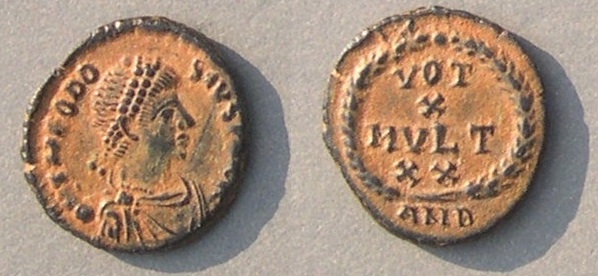 Vows with two numbers in a wreath are common on late Roman coins. This is a small coin of
Vows with two numbers in a wreath are common on late Roman coins. This is a small coin of
Theodosius (379-395).
AE4. 13 mm. 1.52 grams.
DN THEODOSIVS PF AVG
VOT/X/MVLT/XX in a wreath,
ANB in exergue.
RIC IX Antioch 56c, page 289, struck 379-383.
This same type was issued simultaneously for his three co-emperors, including Gratian who had been emperor since 367. Because the four rulers were elevated in different years, this vow-number pair must belong to only one of the emperors, the senior emperor Gratian. The similar coins with different vow numbers (VOT V, VOT V MVLT X, VOT XV MVLT XX, VOT XX MVLT XXX) were issued at the same time giving the vows of different co-emperors.
(Go to a page on vota coins of Valentinian I and later emperors (364-455), including Magnus Maximus, Theodosius II, and Valentinian III)
 Vows on Gold Coins. Many late Roman gold coins have vota types. In the second century and early part of the third century, the vota types on denarii were often simultaneously issued as gold aurei. This web site does not discuss gold other than to illustrate this one late Roman solidus.
Vows on Gold Coins. Many late Roman gold coins have vota types. In the second century and early part of the third century, the vota types on denarii were often simultaneously issued as gold aurei. This web site does not discuss gold other than to illustrate this one late Roman solidus.
Theodosius. 379-395.
Solidus 22 mm.
VOT/V/MVLT/X inscribed on a shield which Constantinopolis is holding on the arm of the throne.
DN THEODO-SIVS PF AVG
CONCORDI-A AVGGGG B
CONOB in exergue.
RIC IX Constantinople 47b page 224 "379-383".
Solidi under the Byzantine empire (Anastasius and later) did not employ vota types.
 Vows on Silver Siliquae. Many late Roman silver siliqua from the time of Constantius II and later have vota types.
Vows on Silver Siliquae. Many late Roman silver siliqua from the time of Constantius II and later have vota types.
Siliqua. 18-16 mm.
Julian II, the Apostate. Caesar 355-360 and Augustus 360-363.
DN FL CL IVLI-ANVS PF AVG
VOT/X/MVLT/XX in wreath
TCONST below (for T = 3rd officina, CONST = Constantina, now Arles)
RIC VIII Arles 309 page 228 "Spring 360 - 26 June 363".
Julian did not rule long enough to celebrate vows for ten years soluta.
Cathy King wrote Roman Silver Coins and Their Values, volume V, Carausius to Romulus Augustus, which is the indispensable work for siliquae. This web site does not have a page on the numerous vota types on siliquae, but it does have many illustrated on a page on siliquae.
DN THEODOSIVS PF AVG, bust right
T V/XXX/V (35 years)
in wreath over CON
Some have "VT" for VOT but this one is blundered to "T V".
RIC X 457, noting it is sometimes "T V". "435" The example on Plate 18 is worse.
Hahn 5th C. 88a (Constantinople) plates 4-5, "435"
Scholars agree that "35" on this type really does refer to the proper date for vows for 35 years, maybe a bit in anticipation.
(Go to a page with more about the last Roman vota coins.)
 Byzantine Coins. Very few Byzantine coins mention vota. This tiny AE4 is one.
Byzantine Coins. Very few Byzantine coins mention vota. This tiny AE4 is one.
Justinian, 527-565, struck year 13 (539/540) at Carthage, which was reconquered from the Vandals in 533.
9 mm. 0.73 grams.
Bust right (very weak, as usual)
VOT/XIII in wreath.
Sear Byzantine 278. MIBE 205 year 13. DO 303.
Under the Byzantine empire only this tiny type, known from four vota years, mentions vota. Otherwise, only a few rare silver types under Justinian mention vota.
(Go to a page with the Byzantine coins that mention vota.)
Go to a page on dating vota coins.
Go to the list of references. Return to the top of this page.
Go to the Table of Contents for this whole educational site.
Return to the coin above listed here in order:
8) Vows in a wreath with the year more or less spelled out, e.g. VOTIS DECENNALIBVS
10) Vows are rare on Roman provincial coins, but occur on one type of Gallienus at Alexandria.
11) Vows in a wreath with two numbers (Probus and later. Very common after 350)
12) Pre-reform radiates under Diocletian and Maximian.
13) Post-reform radiates under the tetrarchy.
14, 15) Small fractional folles under the tetrarchy and later are rare. Their types are generally vota types (mostly from Trier, but including a few from Rome). Maximian took vows for XXX years.
Maxentius issued vota coins.
16) "Two victories" under Constantine holding a shield between them with "VOT PR" and without a vow number
17, 20) Vows for multiples of five years including 15 years (and 25 years, in addition to 10, 20, 30) began to be recorded on coins in the fourth century.
18) Licinius and an issue from Thessalonica.
19, 21) Vows under Constantine for X, XX, and XXX years
22) VOT V MVLT X under Magnentius
Julian II and Jovian issued vota coins.
23) Vows on AE4s under the houses of Valentinian and Theodosius
24) Vows are common on gold aurei and late Roman solidi (This web site emphasizes lower denominations. Gold is barely considered.)
25) Late Roman silver siliquae are not common, but most siliqua types have vows.
26) The last copper vota type before Byzantine coins was of Theodosius II (402-450) c. 437.
27) There are very few Byzantine types that mention vota. They are all for Justinian from Carthage.
28) Departures and arrivals of emperors were accompanied by vows, but the corresponding PROFECTIO and ADVENTVS types (not above, rather on linked pages) depict the travel and do not mention the vows.
RIC = Roman Imperial Coinage, a series in ten volumes.
Pearce, J.W.E. "The vota-legends of the Roman coinage," Numismatic Chronicle (1937) 5th series volume XVII, pages 112-123. [Pearce was the author of RIC IX (published 1933) on this time period. This article concentrates on the period of RIC IX with only occasional mention of earlier coins. It addresses dates and whether vota X would be soluta when the year X was begun or when it was ended.]
Rupke, Jorg. Religion of the Romans. Originally in German in 2001. Translated into English for the 2007 book.
Jones, John Melville. Dictionary of Ancient Roman Coins.
Grierson, Philip and Melinda Mays. Catalogue of Late Roman Coins in the Dumbarton Oaks Collection and in the Whittmore Collection (from Arcadius and Honorius to the accession of Anastasius). 1992. Hardcover 499 pages and 37 plates. [i.e. from AD 383 to 491. Discusses the end of Vota coins on page 12 and dating.
Mathisen, Ralph. "The periodic vota of the late Roman empire," 1972-1973, SAN IV.3, pages 43-45. [Very old and no longer useful.]
King, Cathy. Roman Silver Coins, volume V. 1987. [The silver siliqua denomination often has VOTA types, especially during and after Constantius II became Augustus (337). This book serves as a convenient list of the types.
Sear, David. Roman Coins and their Values, volume II, 2002.
Sear, David. Roman Coins and their Values, volume III, 2005
Sear, David. Roman Coins and their Values, volume IV, 2011
Sear, David. Roman Coins and their Values, volume V, 2015
Wilken, Robert L. The Christians as the Romans saw them, 1984.
Zschucke, Carl-Friedrich. Die Bronze-Teilstuck-Pragungen der romischen Munzstatte Trier. Paperback. 1989. 65 pages including 227 types, almost all illustrated.
Return to the top of this page.
Leave the vota pages and go to the main Table of Contents page for this whole site.